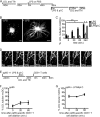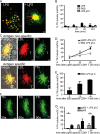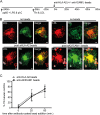Tubulation of endosomal structures in human dendritic cells by Toll-like receptor ligation and lymphocyte contact accompanies antigen cross-presentation
- PMID: 24235148
- PMCID: PMC3879573
- DOI: 10.1074/jbc.M113.511147
Tubulation of endosomal structures in human dendritic cells by Toll-like receptor ligation and lymphocyte contact accompanies antigen cross-presentation
Abstract
Mouse dendritic cells (DCs) can rapidly extend their Class II MHC-positive late endosomal compartments into tubular structures, induced by Toll-like receptor (TLR) triggering. Within antigen-presenting DCs, tubular endosomes polarize toward antigen-specific CD4(+) T cells, which are considered beneficial for their activation. Here we describe that also in human DCs, TLR triggering induces tubular late endosomes, labeled by fluorescent LDL. TLR triggering was insufficient for induced tubulation of transferrin-positive endosomal recycling compartments (ERCs) in human monocyte-derived DCs. We studied endosomal remodeling in human DCs in co-cultures of DCs with CD8(+) T cells. Tubulation of ERCs within human DCs requires antigen-specific CD8(+) T cell interaction. Tubular remodeling of endosomes occurs within 30 min of T cell contact and involves ligation of HLA-A2 and ICAM-1 by T cell-expressed T cell receptor and LFA-1, respectively. Disintegration of microtubules or inhibition of endosomal recycling abolished tubular ERCs, which coincided with reduced antigen-dependent CD8(+) T cell activation. Based on these data, we propose that remodeling of transferrin-positive ERCs in human DCs involves both innate and T cell-derived signals.
Keywords: Cell-Cell Interaction; Cross-presentation; Dendritic Cells; Endosomes; Intracellular Trafficking; Live Cell Confocal Microscopy; Recycling; T Cell Receptor; Toll-like Receptor (TLR); Tubulation.
Figures





Similar articles
-
Requirements for T cell-polarized tubulation of class II+ compartments in dendritic cells.J Immunol. 2003 Dec 1;171(11):5689-96. doi: 10.4049/jimmunol.171.11.5689. J Immunol. 2003. PMID: 14634076
-
T cells induce extended class II MHC compartments in dendritic cells in a Toll-like receptor-dependent manner.J Immunol. 2003 Oct 15;171(8):4081-8. doi: 10.4049/jimmunol.171.8.4081. J Immunol. 2003. PMID: 14530329
-
TLR7 triggering with polyuridylic acid promotes cross-presentation in CD8α+ conventional dendritic cells by enhancing antigen preservation and MHC class I antigen permanence on the dendritic cell surface.J Immunol. 2013 Feb 1;190(3):948-60. doi: 10.4049/jimmunol.1102725. Epub 2013 Jan 2. J Immunol. 2013. PMID: 23284054
-
Different routes of MHC-I delivery to phagosomes and their consequences to CD8 T cell immunity.Semin Immunol. 2023 Mar;66:101713. doi: 10.1016/j.smim.2023.101713. Epub 2023 Jan 25. Semin Immunol. 2023. PMID: 36706521 Free PMC article. Review.
-
Heat shock protein magic in antigen trafficking within dendritic cells: implications in antigen cross-presentation in immunity.Acta Med Okayama. 2012;66(1):1-6. doi: 10.18926/AMO/48075. Acta Med Okayama. 2012. PMID: 22358133 Review.
Cited by
-
The role of MHC class I recycling and Arf6 in cross-presentation by murine dendritic cells.Life Sci Alliance. 2019 Nov 18;2(6):e201900464. doi: 10.26508/lsa.201900464. Print 2019 Dec. Life Sci Alliance. 2019. PMID: 31740564 Free PMC article.
-
The comings and goings of MHC class I molecules herald a new dawn in cross-presentation.Immunol Rev. 2016 Jul;272(1):65-79. doi: 10.1111/imr.12428. Immunol Rev. 2016. PMID: 27319343 Free PMC article. Review.
-
Regulation of the Cell Biology of Antigen Cross-Presentation.Annu Rev Immunol. 2018 Apr 26;36:717-753. doi: 10.1146/annurev-immunol-041015-055523. Epub 2018 Feb 28. Annu Rev Immunol. 2018. PMID: 29490164 Free PMC article. Review.
-
Endocytic Recycling of MHC Class I Molecules in Non-professional Antigen Presenting and Dendritic Cells.Front Immunol. 2019 Jan 7;9:3098. doi: 10.3389/fimmu.2018.03098. eCollection 2018. Front Immunol. 2019. PMID: 30666258 Free PMC article. Review.
-
MICAL-L1-related and unrelated mechanisms underlying elongated tubular endosomal network (ETEN) in human dendritic cells.Commun Integr Biol. 2014 Dec 23;7(6):e994969. doi: 10.4161/19420889.2014.994969. eCollection 2014 Dec. Commun Integr Biol. 2014. PMID: 26478765 Free PMC article.
References
-
- Villadangos J. A., Schnorrer P. (2007) Intrinsic and cooperative antigen-presenting functions of dendritic cell subsets in vivo. Nat. Rev. Immunol. 7, 543–555 - PubMed
-
- Burgdorf S., Schölz C., Kautz A., Tampé R., Kurts C. (2008) Spatial and mechanistic separation of cross-presentation and endogenous antigen presentation. Nat. Immunol. 9, 558–566 - PubMed
Publication types
MeSH terms
Substances
LinkOut - more resources
Full Text Sources
Other Literature Sources
Research Materials
Miscellaneous

